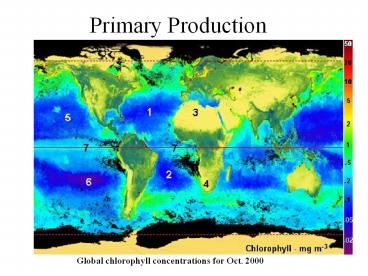Primary%20Production - PowerPoint PPT Presentation
Title:
Primary%20Production
Description:
Involves the use of light energy in the conversion of inorganic carbon into ... Plankton Size. microplankton. Picoplankton (.2-2 m) Nanoplankton (2 - 20 m) ... – PowerPoint PPT presentation
Number of Views:79
Avg rating:3.0/5.0
Title: Primary%20Production
1
Primary Production
Global chlorophyll concentrations for Oct. 2000
2
Feb 5, 1998 uniformly low pigment concentrations
during all seasons
3
Primary Productivity
- Photosynthesis
- Involves the use of light energy in the
conversion of inorganic carbon into organic
carbon. - Photosynthetic organisms include terrestrial
plants, seaweeds, phytoplankton, blue-green
algae, and zooxanthellae.
4
Primary Productivity
- Chemosynthesis
- Involves the use of energy released by the
catalysis of certain inorganic reaction to
convert inorganic carbon into organic carbon. - Chemosynthetic organisms include hydrothermal
vent bacteria.
5
Table 1. Average net primary production and
biomass of aquatic habitats. Data from R.H.
Whittaker and G.E. Likens, Human Ecol. 1
357-369 (1973).
6
Primary Production Limitations
- light
- nutrients
Photic Zone
Photosynthesis
No Photosynthesis
Aphotic Zone
7
Primary Productivity
- Gross Primary Productivity (GP)
- The rate of production of organic matter from
inorganic materials by autotrophic organisms - Respiration (R)
- The rate of consumption of organic matter
(conversion to inorganic matter) by organisms. - Net Primary Productivity (NP)
- The net rate of organic matter produced as a
consequence of both GP and R.
8
Primary Productivity
- NP GP R
Note that R is a negative value because it
results in the reduction of organic matter.
9
Phytoplankton
Zooplankton
10
RP
11
Plankton Sampling
12
(No Transcript)
13
Plankton Size
Picoplankton (.2-2 µm) Nanoplankton (2 - 20
µm) Microplankton (20-200 µm) Macroplankton
(200-2,000 µm) Megaplankton (gt 2,000 µm)
microplankton
picoplankton
nanplankton
14
Light Dark Experiments
Respiration C6H12O6 6O2
6CO2 6H2O
15
buoy
dark bottle
light bottle
respiration
photosynthesis respiration
weight
16
- LIGHT LEVELS have a major impact on productivity
- light intensity
- - with depth
- - penetration depends on water clarity
- light quality
- changes with depth
- longer (e.g., red) more quickly
- amount of light
- - to little or too much light inhibit
photosynthesis - primary production
- - different primary producers peak production at
- different light intensities
- (algae gtdiatomsgtdinoflagellates)
- compensation depth
- - depth at which rate of photosynthesis rate
of - respiration
17
- VERTICAL MIXING also influence productivity
- critical depth
- depth at which net photosynthesis per mixing
cycle exceeds net respiration - determined by the time spent at different depths
due to vertical mixing
- Upwelling zones
- Thermocline layer
- Diurnal vertical migration
- Langmuir vortices
18
- NUTRIENTS often limit productivity
- inorganic nutrients
- - nitrogenous compounds (NO3, NO2, NH3)
- - phosphates (PO4)
- trace elements may also be important (e.g., Fe,
- Cu)
- nitrate concentrations in rich seawater 1/10,000
- of rich soil
- nutrients produced by
- - excretion
- - surface runoff
- - upwelling
19
- Productivity varies TEMPORALLY and SPATIALLY
- generally highest over continental shelves over
the shelf itself it is highest just offshore - seasonality more pronounced at high latitudes
- at mid latitudes, productivity peaks both spring
and fall
20
Primary Production
biomass
zooplankton
phytoplankton
Winter Spring Summer Fall
North Atlantic- temperate climate
21
Arctic
zooplankton
phytoplankton
Winter Spring Summer Fall
22
Tropical
zooplankton
phytoplankton
Winter Spring Summer Fall
23
Environmental Factors Affecting Primary Production































